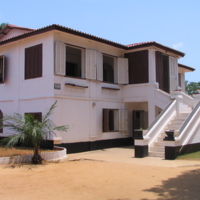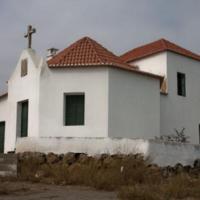
Le musée d'histoire de Ouidah
Le musée d'histoire de Ouidah (The Ouidah Museum of History) is located within the Old Portuguese Fort in Ouidah. The Fort was used to contain and transport enslaved Africans as part of the transatlantic slave trade, serving as the site for diplomatic presence of Portugal in the area. The fort became property of the Dahomean government in 1961, when it was restored and turned into a museum, opening in 1967. It is managed by the Department of Cultural Patrimony.
The museum's collections are grouped into six major exhibit themes: the Portuguese Fort (in which the museum resides), the Kingdom of Xwéda, the Kingdom of Dahomey, the Slave Trade, Vodun, and the cultural links between Benin and the New World. These collections are made up of artefacts, photographs and objects that have significant meaning to the history and culture of the museum's local area.
The history of slavery runs throughout the displays; from the Portuguese Fort display which discusses how enslaved Africans were kept there. The displays that explore the kingdoms of Xwéda and Dahomey use collections to emphasise the extent to which both of them were dependent on the trade in enslaved individuals with Europeans for riches and power. These include a range of archaeological finds, as well as engravings and drawings. The exhibition about the religious traditions of the area, in particular the development of Voodoo, reflects on the continued use of African religions by enslaved people in the Americas during the period of the transatlantic slave trade, using religious artefacts. A range of images and objects showcase the impact that people from Benin made on the cultures of New World societies, as well as the effects of mass repatriation to Benin after the decline of the slave trade.
The Slave Trade exhibits examine the system of transatlantic slavery from the sixteenth to the nineteenth century and how it impacted on the local area. The main focus is on the economic and social processes that the slave trade created in Benin, capture, enslavement and the Middle Passage. These themes are illustrated with a range of objects, artists' renditions and archival materials. Examples of objects on display include chains and yokes. Images are also used to give some information about the plantation system in the Americas and Caribbean.

National Museum of Slavery
The Angolan National Museum of Slavery (or Museu Nacional da Escravatura in Portugese) was founded by the National Institute of Cultural Patrimony in 1997. Its main aim is to depict the history of slavery in Angola. The museum is situated in a chapel which once belonged to Álvaro de Carvalho Matoso, one of the largest Portugese slave-traders in the eighteenth century. It is also next door to Capela da Casa Grande, a seventeenth-century structure which was once used for baptising enslaved Africans before they were shipped to the Americas. The museum has a large collection of items that were utilised in the slave trade, as well as items relating to African culture pre- and post- transatlantic slave trade and a vast photography collection. Situated 15.5 miles outside the city of Luanda, the museum forms an extraordinary landmark along the "Slave's Route."
While the museum itself is realtively modest, it's aim is a big one; 'it is a testament and a reminder of the history of the Angolan people who lived in the day of slavery and it stands as a monument to those who suffered and were affected by slavery.' The narrative in the museum focusses predominantly on Portugal, the main European slave trader in the Angola region. It provides a contextual history of the Atlantic Slave Trade, as well as highlighting slavery in Africa before the involvement of Europeans.